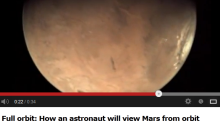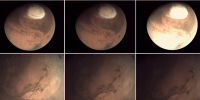You might have noticed that VMC – the Mars Webcam – has been quiet recently. Don’t worry: it’s all expected – it’s just further proof of the challenges and excitement of planetary spaceflight!
Today, Mars is at the worst point of a period known as ‘solar conjunction’, which means that Mars is on the exact opposite side of the Sun from Earth. Seen from the Earth at around 16:00 today, Mars appears only 0.7658 degrees from the Sun – less than the width of your finger held at arm’s length!
This results in major disturbances in our communications from Earth to Mars Express and back; as a result the spacecraft has been put into an autonomous operations mode, with all activities on hold until we come out the other side.
The video above shows the Sun from the start of this year until today – with the streamer-like tendrils of its atmosphere, the corona. Coming in from the left of the video is a bright speck – Mars! Invisible here is the tiny dot of Mars Express orbiting the red planet. Our problem communicating with Mars Express comes from the fact that the radio beam from the spacecraft has to pass through this atmosphere, getting distorted on the way.
On top of that, our dish antennas on Earth have problems picking out the weak signal from Mars Express from the ‘noise’ of the Sun. All of this makes this period, about a month long, especially challenging for communications with all Mars missions.
To keep the spacecraft safe, we have to give it enough information for it to look after itself for the month when we are passing behind the Sun. There’s simply not enough memory on the spacecraft to also include instructions on how to carry out its normal activities (including VMC imaging!) – all the space is used up with our commands on how to look after itself for a month alone, out of contact with Earth!
The video above was produced using the excellent JHelioViewer tool, developed with funding from ESA and NASA.
It shows in blue and red the view from the LASCO instrument on the ESA/NASA SOHO solar observatory mission. This instrument puts a disc in front of the Sun to block the direct light, and what can be seen is the corona, and in this case, Mars passing behind it. In the centre are images from the NASA Solar Dynamics Observatory AIA instrument, showing the blazing Sun in the middle of our solar system. – Thomas



Discussion: no comments